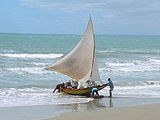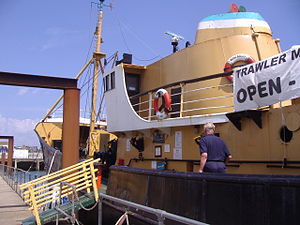- Mincarlo (trawler)
-
Career (England) 
Name: Mincarlo Owner: W H Podd Ltd.
Sold to Putford Enterprises.
Sold to Lydia Eva TrustPort of registry: Lowestoft Builder: Brooke Marine, Lowestoft Cost: £76,600 Yard number: Yard 281 Laid down: 1960 Launched: 25 September 1961 In service: 28 years Identification: LT412
Reg No: 303677
Call sign: GHXBStatus: Museum ship: floating Notes: Sold to the Lydia Eva Trust for £1 and then preserved. General characteristics Class and type: Sidewinder trawler Tonnage: 166 grt, 56 net Length: 108.75 ft (33.15 m) Beam: 22.7 ft (6.9 m) Depth: Moulded: 11.25 ft (3.43 m) Installed power: Engine No: 117 by AK Diesels Ltd: 5-cylinder, vertical, 4 stroke cycle, naturally aspirated, developing 500 shp continuously at 320 revs. Driving through an AK Diesel 2:1 ratio reverse reduction gearbox to give a propeller speed of approximately 160rpm. Speed: 10 knots (19 km/h) Crew: 11 Notes: Fresh water capacity: 7 tons
Fish Hold Capacity: 5,200 cu ft (150 m3) including 690 cu ft (20,000 L) ice room.Mincarlo is the last surviving sidewinder fishing trawler of the Lowestoft fishing fleet.[1] She is also the last surviving fishing vessel built in Lowestoft, with an engine made in the town.
Contents
Construction
The Mincarlo was built in the Brooke Marine yards in the Suffolk town of Lowestoft.[2] in 1961. She was one of three sister ships built for W.H. Podd Ltd. The other two ships were called Bryher and Rosevear, and along with Minicarlo were named by the Podd family after small islands which make up part of the Isles of Scilly of the Cornish coast. Each of the vessels cost £75,600.
Sidewinder trawling method
The Mincarlo was the type of trawler known as a sidewinder or side trawler. On sidewinders, the trawl nets are deployed over the side with the trawl warps passed through blocks suspended from two gallows. These gallows were forward and aft, on the starboard side of the Mincarlo. The fishing gear consisted of two otter trawls each of which was fitted with otter boards. Otter boards keep the mouth of the trawl net open and are positioned in such a way that the hydrodynamic forces, acting on them when the net is towed along the seabed, pushes the boards outwards. This keeps the mouth of the net open. The nets were attached to heavy duty ground ropes, 40 feet (12 m) long, which held the nets on the seabed and ticked up any fish lying on or below the sand. Until the late sixties, sidewinders were the most common deep sea boat used in North Atlantic fisheries. They were used for a longer period than other types of trawler.[3]
Working life
Mincarlo was part of the 50 to 60 strong fishing fleet out of the Suffolk seaport of Lowestoft. During her 13 years her catches put her in the top half dozen trawlers of the fleet. Her catches consisted of cod, haddock, plaice, skate and sole. She had been in the ownership W. H. Podd Ltd until she was purchased from them by Putford Enterprises in 1975. At this time Putford Enterprises[4] owned and operated a large fishing fleet, with many vessels at Lowestoft and Grimsby. From the very early days of oil and gas exploration in the southern North Sea, Putford Enterprises along with its fishing craft, also operated many safety standby ships for the offshore oil and gas industry. In 1977 Mincarlo was converted and began a new career as a stand-by vessel in the flourishing southern North Sea gas fields. She was also re-named and was now called Putford Merlin. In 1989 after a career which had spanned 28 years, she was finally replaced by a built for purpose stand-by ship. She was laid-up, back were she began life, at the yard of Brooke’s.
Restoration
After her working life had finished she was sold by Putford Enterprise to the Lydia Eva Trust who paid a nominal £1 to Putford. After a period of restoration and refurbishment the Mincarlo was opened to the public in 1998. The Mincarlo is on display at Lowestoft Yacht Harbour and is sometimes moved to the Heritage Quay at Great Yarmouth. Admission is free.
Mincarlo is now owned by the Lydia Eva and Mincarlo Charitable Trust, a registered charity,[5] which also owns the preserved herring drifter Lydia Eva.
Gallery
See also
- Excelsior - last surviving Lowestoft fishing smack
References
- ^ Mincarlo Website. Retrieved 16 June 2009.
- ^ Ordnance Survey (2005). OS Explorer Map OL40 - The Broads. ISBN 0-319-23769-9.
- ^ FAO: Fishing Vessel type: Side trawlers
- ^ The Boston Putford Story. Retrieved 20 June 2009.
- ^ Lydia Eva and Mincarlo Charitable Trust, Registered Charity no. 803654 at the Charity Commission
External links
About fishing vessels Commercial - Commercial fishing boats
- Trawlers
- Seiners
- Drifters
- Longliners
- Factory ships
- Fishery Protection Squadron
- Fishing fleet
- Research vessels
- Whalers
- Whaling ships
- British ships
- Japanese ships

Traditional - Traditional fishing boats
- Bawley
- Bokkura
- Caïque
- Cape Islander
- Chasse-marée
- Coble
- Coracle
- Couta
- Currach
- Dogger
- Dhoni
- Dugout
- Falkuša
- Felucca
- Fifie
- Friendship sloop
- Galway hooker
- Herring buss
- Jangada
- Jukung
- Kolae
- Lugger
- Luzzu
- Mackinaw
- Monterey clipper
- Nobby
- Pirogue
- Poveiro
- Reed boat
- Sampan
- Sgoth
- Shad boat
- Sixareen
- Smack
- Sneakbox
- Well smack
- Yawl
- Yoal
Dories Oyster boats Recreational Builders and designers Fisheries and fishing topic areas Fisheries 
Fishing - Fisherman
- Artisan fishing
- Fishing villages
- Fishing vessels
- Fishing history
Industrial Recreational Techniques Tackle Locations - Fishing by country
- Fishing villages
- Fishing banks
- Fish ponds
- Marine habitats
- Index of fishing articles
- List of fishing topics by subject
- Fisheries glossary
Categories:- Fishing vessels
- Museum ships in the United Kingdom
- 1961 ships
- Fishing vessels of the United Kingdom
- Museums in Suffolk
Wikimedia Foundation. 2010.










